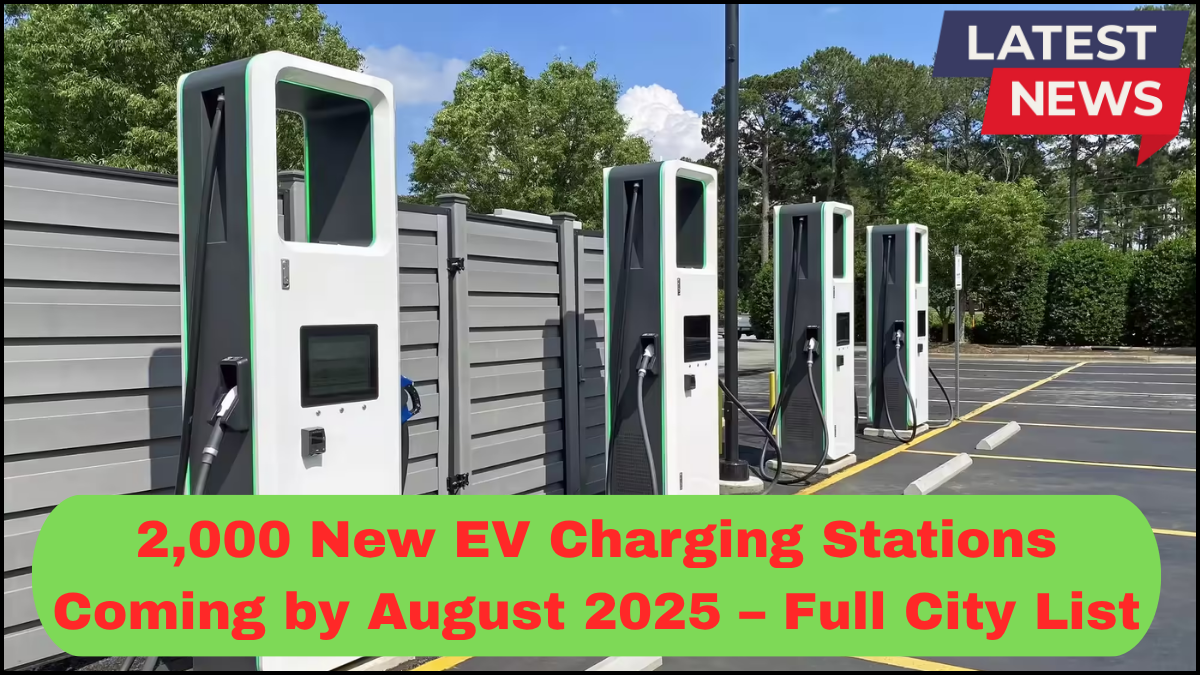India is set to take a major leap toward sustainable transportation with the announcement of 2,000 new EV charging stations rolling out across the country by August 2025. This ambitious move aims to strengthen the EV Charging Stations India network, improve long-distance travel for electric vehicle owners, and reduce range anxiety—one of the biggest hurdles in EV adoption.
This nationwide expansion aligns with the government’s goal to position India as a global EV hub and transition towards greener mobility.

Why This Expansion Matters
The upcoming 2,000 stations are not just a number—they represent a strategic step toward building a Fast Charging Network 2025 that supports India’s rapidly growing fleet of electric two-wheelers, cars, and commercial vehicles. With vehicle electrification on the rise, the charging infrastructure needs to scale accordingly.
Currently, India has just over 8,700 public EV chargers (as per Ministry of Power, 2024 data). The addition of 2,000 more chargers—many of them fast-charging units—will provide essential support to the projected 5 million EVs expected on Indian roads by the end of 2025.
Key Features of the New EV Charging Stations
Here’s what users can expect from this rollout:
-
Fast Charging Capability: Most new installations will support DC fast charging, drastically reducing waiting time. For example, a 30-minute charge could provide up to 80% battery capacity for most EVs.
-
Smart Navigation & Reservation: Many of these stations will be integrated with mobile apps, allowing real-time availability tracking and advance booking to avoid wait times.
-
24/7 Accessibility: Designed for convenience, the majority will be located at public places like malls, highways, parking lots, fuel stations, and metro stations.
-
Grid Management Integration: These chargers will be linked to smart grid systems to prevent overloading and allow for energy balancing.
-
Solar + Battery Backup: Select stations, especially in tier-2 cities and remote locations, will also be equipped with solar panels and battery backups to ensure reliable service even during grid failures.
Full List of Cities Getting New Charging Stations
Here’s a breakdown of key cities and regions where the new EV charging infrastructure will be installed by August 2025:
Metro Cities (High-Density Zones)
-
Delhi – 150 new stations across NCR, including Noida, Gurugram
-
Mumbai – 120 locations focused on public parking and commercial hubs
-
Bangalore – 130 chargers across tech parks, highways, and residential areas
-
Hyderabad – 100 stations including airport corridors and metro routes
-
Chennai – 90 stations in IT corridors and transport hubs
-
Kolkata – 85 locations prioritized in East-West transit zones
Tier-2 and Emerging EV Markets
-
Pune – 75 new fast chargers, especially along the expressway
-
Ahmedabad – 60 stations around educational institutes and malls
-
Lucknow – 50 installations, focusing on mixed-use developments
-
Jaipur – 45 charging points around tourist hotspots and city ring roads
-
Indore – 40 smart chargers at railway stations and public transport zones
-
Bhubaneswar – 35 stations integrated with city e-bus routes
Highway and Intercity Corridors
-
Mumbai–Pune Expressway – 40 high-speed chargers at rest stops
-
Delhi–Chandigarh Route – 35 stations every 50 km
-
Bangalore–Chennai Corridor – 30 fast chargers at toll plazas
-
Golden Quadrilateral Highway (select patches) – 100 fast charging stations spaced to support long-range travel
Government & Private Sector Partnership
This rollout is being supported by a combination of public investment and private sector collaboration. Leading EV charging infrastructure providers like Tata Power, Ather Grid, and ChargeZone are actively involved. The government’s FAME-II incentives have made it viable for startups and energy firms to invest in this rapidly growing space.
In many cases, state governments are offering additional subsidies, faster land approvals, and lower electricity tariffs to speed up implementation.
Fast Charging Network 2025 – A Vision in Action
The Fast Charging Network 2025 plan is not just about quantity—it’s about strategic placement, user convenience, and sustainability. India’s EV infrastructure roadmap aims to make EV ownership as convenient and reliable as traditional fuel vehicles, reducing friction for both individual and commercial users.
With charging times dropping and availability rising, EVs will soon become the default choice for many Indian drivers—especially in urban centers.
FAQs
Q1: Will all the new charging stations support fast charging?
A: Not all, but a significant majority will include fast DC charging. Some locations may also have slower AC chargers for overnight or long-duration parking.
Q2: Are these stations accessible to all types of EVs?
A: Yes, the new stations are designed to support a wide range of EVs, including two-wheelers, three-wheelers, passenger cars, and electric buses, with multiple connector types.
Q3: Is there a way to locate and book a charging station in advance?
A: Absolutely. Major providers will offer real-time availability and reservation features via mobile apps like Tata Power EZ Charge, Ather Grid, and others.
Q4: Will rural areas also benefit from this rollout?
A: While the focus is on urban and intercity corridors, select rural hubs and towns are being covered, especially those along key highways.
Q5: How will this impact EV adoption in India?
A: Enhanced infrastructure is expected to drive consumer confidence, leading to higher EV adoption across all segments—from scooters to fleet vehicles.
clcik here to learn more